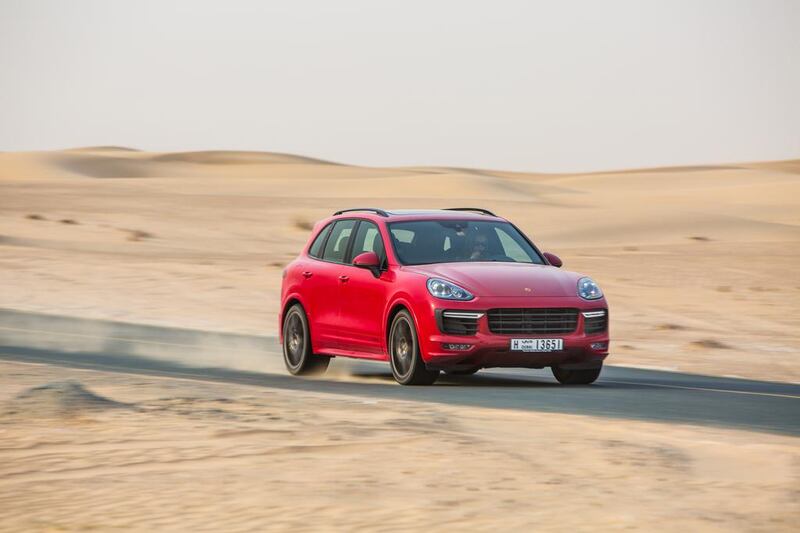If you’re still hung up on whether Porsche should be making an SUV, it is really time you got over it. It’s been more than a decade since the first Cayenne landed, and the biggest criticism anyone could level at it at the time was that its capability defied logic both on and off piste.
If ever there was a smackdown for the purist whose stoicism is entrenched in two-door Porsches, it’s this: the company simply wouldn’t exist today if it wasn’t for them. Of the 190,000 cars bearing the golden shield of Stuttgart sold globally last year, 70 per cent of them had more than two doors. By contrast, the 911 in all of its guises – 25 at last count – accounted for just 16 per cent of the global sales.
One in every three Porsches sold around the globe is a Cayenne, making it the marque’s biggest seller. The most-popular derivative is the GTS which slots between the Cayenne S and Cayenne Turbo, in terms of both price and performance. The GTS gets the wider arches and styling of the Turbo models, but the same base 3.6-litre twin-turbo V6 that Porsche fits to the Cayenne S.
Yes. A twin-turbo V6. Porsche understands that while the Cayenne is primarily designed to shift five people about in relative comfort and luxury, its drivers like their cars to be nippy. You may recall that the outgoing model was fitted with a naturally aspirated V8 that made around 420 horsepower, 550 Nm torque and a ruckus from the exhausts when you buried the throttle into the carpet.
The new GTS may have lost two cylinders, but has gained 20 horsepower and 50 Nm in the transition to turbo-power – which is more than enough to propel the two-tonne five-seater to 100kph in just over five seconds. That’s half a second quicker than the V8-powered model it replaced, and is fast enough to trouble the tailpipes of a current 911 Carrera if you’ve got your wits about you.
You’ll need them too. That five seconds disappears in a flurry of barely perceptible gearshifts with a surge of torque that keeps your skull pinned to the GTS-embroidered headrests. Porsche says the GTS will press on to a top speed of 262kph – and I can find no reason to doubt it. You’ll certainly achieve speed-camera triggering speeds without too much effort, and you really need to keep an eye on the speedo if you’ve got a heavy right foot and want to avoid a trip to the police station. Porsche lavishes a few standard extras on the GTS that you simply can’t get on models lower down the Cayenne food chain. The GTS gets the same 390mm (front) and 358mm (rear) brake discs and red callipers the company fits into the Turbo model; the sports exhaust comes standard, as does the Porsche Active Suspension Management system and air suspension.
The nose section, with its larger side intakes for cooling, has also been lifted from the Turbo, as have the 20-inch RS Spyder wheels. The car owes its subtle svelte curves to the Sport Design package, which includes sleek side sills, wheel arch extensions, a roof spoiler and reprofiled rump. The GTS is accented with black details that include the GTS letters on the fenders, the dual tailpipes, the inner workings of the headlights and the darkened LED rear lights. The exterior colour, Carmine Red, is a cost option first introduced on the GTS at the LA Motor Show last year, and is now available across the board.
Inside, the GTS gets eight-way adjustable sports seats finished in alcantara and leather with red contrast stitching. The red tach fascia is a cost option that really underscores the car’s sports heritage, while the centre console grab handles give the hint that the car has more than on-road velocity and lateral grip in its arsenal.
While it’s true that very few Cayenne GTS owners will ever risk damaging those wheels by venturing off road and rock-crawling through wadis, Porsche believes that those who do should not be compromised. The 45 profile tyres don’t offer much in the way of latitude for off-roading on sand, but the company has gone to great lengths to ensure that the Cayenne is as capable off-road as it is on. It shares the same Porsche Traction Management system the carmaker fits for the rest of the Cayenne range, and you’re able to lock the rear diff or dial in one of the many off-road settings that Porsche has helpfully mapped out for you.
Learning to trust the car and the experts behind the presets is probably the biggest hurdle you’ll have to overcome. That, and understanding that Porsche’s boffins are more than just track-oriented speed hounds hell-bent on ultimate performance helps.
Quality has a tactility that can’t be faked. You’re drawn to it by instinct, and you know, from the first touch, that it has been designed and created by a team of people with a long tradition in fashioning things with their hands. The Cayenne GTS may seem more at home on the road, but it’s nice to know that for those rare moments that you want to taste adventure, it’s up to the task. And there really is no better way to travel.






